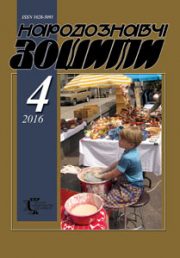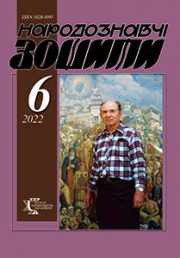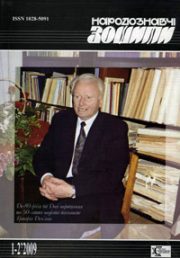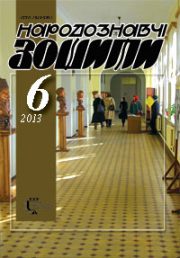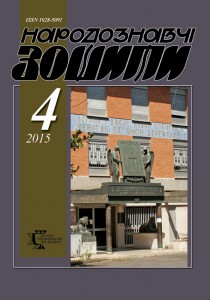
Vovkanych Stepan. On national and international security of the present time: a socio-humanistic concept. P. 751
In the article has been proved a proposed by Ukraine and supported by international society idea that socio-humanist paradigm of international relations will help to protect Ukraine. This approach is be based not on Chauvinist power world rulers, but on that of personal human and community rights of every nation, on harmony and increase of the humanness of man-centered and nation-centered aspects of civilized values, on the rational achievements in the community search for development, social justice and true of cognition. At the same time, presenting its contemporary ideological level, the Ukrainian national idea (UNI) is to expose semantic, axiological and semiotic components of as complex dominant in current and long-term strategy for development of the Ukrainian state system, strengthening of its subjectivity and maintenance of national identity.
Keywords: hybrid war, defense of informational and territorial space, annexation, ideological bases of state building.
read »
Nikolchuk Inna. The folklore of Kievan region in the light of Mykhaylo Hhrushevskyy’s work «The history of Ukraine-Rus». P. 762
The paper pays attention to a germination of Kyiv and Kievan region, which have their roots in Kievan Rus state. The evolution of this powerful political and cultural state lasted through many centuries. The details of the complicated process was analyzed by the scientist, historian, political and public statesman Mykhaylo Hrushevskyy. All the historical events were fixed not only using the official written documents, but also found their place in folklore texts, which transmit facts from the people’s point of view and his truth.
Keywords: state, principality, folklore, social, folk songs, chronicle, the people.
read »
Holyk Roman. Lviv urban folklore, argot and myth of the batyar between various ethnical worlds through 1920—1930. P. 767
The article has been dedicated to some aspects of Leopolitan myth and urban folklore through interwar period. The study has kept up relations of «batyar» language image in then city slang («balaк») with folklore depictions of figure. Mutual influence of literal and folklore mythical images in the context of the polyethnical urban culture of the city in 1920 to1930 has also been analyzed.
Keywords: myth, Lviv, «batyar», «balak», literature, folklore, culture.
read »
Lunyo Yevhen. Satirical vision of moscow-communist occupiers in insurgent carols. P. 777
The article examines the genesis and dynamics of satire on Moscow occupiers in insurgent carols, its traditional and contemporary component, identifies the main objects of satirical depiction and interpretation. Also analyzed ideological and semantic content, artistic and poetic tools and functional specificity of insurgent satire.
Keywords: political satire folklore, insurgent carols, Moscow invaders, the Communists, the Russian occupation.
read »
Seheda Serhii. The grave of Cossack kish chieftain Ivan Sirko: history, legends, studies. P. 786
The article is dedicated to outstanding monument of the Ukraine’s historic past, i. e. to the last resting place of Ivan Sirko, the Cossack Headman, whose activities are winded round with legends and stories. The facts concerning the grave of Cossack chieftain and attitude to it by enemies and local inhabitants, the descendants of Zaporozhian Cossacks have been generalized. Circumstances as for carrying the grave over to its new place and further state of locality have been noted and followed. For the first time have been exposed some results of the craniometrical study in Ivan Sirko’s scull. Outer appearance and anthropological features of Cossack chieftain have been reconstructed on the base of heterogeneous sources.
Keywords: Cossacks, folk stories, Cossack chieftain Ivan Sirko, grave, anthropological traits.
read »
Kostiv Natalya. Yuvenalii Mokrytsky’s figure in Ukrainian sacred art of the XX c. and a problem of identity in foreign national milieu and abroad. P. 798
The article has been dedicated to the creativity of the icon-painter, ascetic monk of the Studite Order Yuvenalii Mokrytskyj, an outstanding representative of Ukrainian sacred art of the 2nd half XX c. both in diaspora as in Ukraine. For the first time the article has brought brief review of Mokrytsky’s biographical data and systematic list of icons painted by him in diaspora and in Ukraine with supplies of attributions, places of icons location, and circumstances of creation.
Keywords: icon, icon art, iconostasis, sacred art, tempera technique.
read »
Kupchynska Larysa. Jan Tysiewicz’ contribution to the studies in activities of Vienna Academy of Fine Arts. P. 805
This article has been dedicated to activities of Jan Tysiewicz, a XIX c. painter and graphic from Western Ukraine, a creative figure who due to certain circumstances contributed to study of Austrian art school traditions. The artist’s contribution to research of curriculum and learning process peculiarities of the Vienna Academy of Fine Arts in the late 1830s — early 1840s has been based upon his own epistolary and artistic heritage. The analysed data throw light on the conceptual view of the Academy’s management board and professors, that consisted in combining practical and theoretical studies, and providing ultimate engagement of students in study activities, which created healthy competition between them. Artist’s epistolary and artistic heritage provide convincing evidence that ultimate teaching methods aimed at the effective solution of educational problems confirmed its status of the leading arts centre in Europe in the XIX century.
Keywords: Jan Tysiewicz, the Vienna Academy of Fine Arts, leading educational establishment of the state, educational process, correspondence, graphics and paintings.
read »
Rudak Oleh. On peculiarities of the development of clerical and architectural traditions of the church interiors in the Precarpathian region through XX c. P. 813
The article has thrown some light upon the factors that influenced the development of church interiors of the Precarpathian region through XX c. The main stages in the development and formation of the church interiors have been described. Leading artists and artistic groups in the sphere of the clerical monumental art have been distinguished. Peculiarities as for the development of clerical and architectural traditions of the church interiors have been put under analysis.
Keywords: church interior, tendency, cathedral, tradition, Precarpathian region.
read »
Bahlay Maria. Beast motifs in summer ritualism of Volhynians in Zhytomyr region. P. 818
This article has been dedicated to cattle motifs typical in the framework of customary and traditional decor of the summer cycle of national calendar. These have been based upon real-life conditions of Zhytomyr region. The complex of protective ritual actions and guard-duties for the preservation of livestock has beenexposed. There have been exemplified various ways in detection of the witches and return of stolen milk.
Keywords: pastoral motifs, folk calendar, Volhynia, Zhytomyr region, witch.
read »
Konopka Volodymyr. The agricultural motives in calendar rituality. P. 825
The paper deals with the problem of investigation of calendar rites under the principles of dominative motives. The main attention is paid to the terminological incertitude of the word «agricultural motive». The principle of motives under the investigation of traditions and rites by the scientists is observed.
Keywords: calendar rites, motive, theme, agricultural motives.
read »
Kosmina Oksana. Some preconditions as to formation of symbolics in traditional ukrainian clothing: an ancient ruthenian dress. P. 830
In the article have been described some wide-spread symbolic signs of clothing in population of Kyivan Rus; the adornments have been considered and examined in accordance with their location over the goods — humeral clothing (shirt, retinue, cloak, lor, casing); half-length clothing (wrapping, trousers, belt); head-dresses (diadems, caps, ribbons); shoe decorations (beads, bangles, finger-rings, and sim).
Keywords: Kyivan Rus’, Ancient Ruthenia, clothing, symbolics, tradition, adornment.
read »
Fedorchuk Olena. Bead components of the garments of Western Podillya of the XIX century. P. 841
The beadwork decoration of the garments of Western Podillya of the XIX century was researched as a separate phenomenon of the national art. The typology, technology and artistic composition grounds of the authentic creations were analyzed. The unique peculiarities of the artifacts of Western Podillya of the XIX century were identified. The scientific research assists the creation of the national beadwork attribute system.
Keywords: beads, adornment, beadwork decoration, garments.
read »
Ivanevych Lilia. On regional and specific aspects of classification as for traditional headwear by Ukrainians of Podilia region (XIX — first half XX cc.). P. 850
On the basis of analysis and systematization of both famous and less-known works and museum collections the problem of formation as for unified classification in traditional headwear by Podilian Ukrainians through ХIX and first half ХХ century has been presented. The attempt to create extended general classification for headwear by Podilian Ukrainians with taking of their regional and specific aspects has been made.
Keywords: Ukrainian folk artistic, historical and geographical regions, the Ukrainians from Podilia, local zones, complex of clothes the Podilian Ukrainians, museums, traditional headwear, classification, regional and specific aspects.
read »
Ablayeva Ulviye. The traditional headgears of the Crimean Tatars: on the problem of classification. P. 860
The paper deals with the problem of classification of the Crimean Tatar traditional headgears: women, men and children. The research is based both on the narrative and visual sources of XVIII—XX centuries, as well as on the personal field materials of the author. All the well-known names of headgears are mentioned, most of which are irrevocably lost.
Keywords: Crimean Tatars, headgears, classification, terminology.
read »
Shcherban Olena. The work of Varvara Shchelokovska as a source of researching the traditional culture of nutrition among the Ukrainians. P. 868
The paper presents an analyses of Varvara Shchelokovska’s work in the area of investigation in the traditional culture of nutrition among the Ukrainians, which is done in the Ukrainian ethnology for the first time. The authors contribution in researching of mentioned theme is explored. The aspects and questions, which need the appropriate attention of contemporary ethnographers, considering demands and level of development of the contemporary ethnology, history, culturology, art studying and ceramology are selected. A conclusion about the high level of informativity and scientific diligence of analyzed V. S. work is maid.
Keywords: Ukraine, Ukrainians, Kupianski district, pottery, tradition, culture of nutrition.
read »
Poshyvailo Svitlana. On history and historiography of Ukrainian cultural ceramology (1900—1920) . P. 875
In the article have been considered some key aspects as for development of Ukrainian cultural ceramology in accordance with defined periods; most significant publications of every formative level in native ceramic craft becoming the kind of folk art during the two first decades of XX c. have been found and characterized.
Keywords: cultural ceramology, ceramics, period, organsof self-government, becoming, Ukrainian researchers.
read »
Lykova Oksana. The ceramological exposition as a source of Ukrainian cultural ceramology. P. 878
The main stages of formation of Ukrainian ceramological exposition in museums are outlined. Attention is focused on the materials, which are valuable sources for Ukrainian cultural ceramology.
Keywords: Ukrainian ceramology, exposition, the history of formation, source, museum.
read »
Gavrysh Larysa. The sale of ceramical wares of the potters from Kharkiv province in the second half of the XIX c. (ways and forms of sale, prices, areas of spreading). P. 883
This paper summarizes information on how (wholesale and retail) and shape (retail sale or exchange by the potter, wholesale sales intermediaries) selling pottery potters Kharkov province in the second half of the nineteenth century; outlines the areas of marketing; set wholesale and retail prices for goods.
Keywords: ceramics, potters, Kharkiv province, sale, wholesale way, the retail way, exchange, fairs, buyers, сhumaks.
read »
Tkachuk Ilona. The cognitive matrix and fractal method of researching the process a perception of paintings. P. 890
This article represents the cognitive matrix-fractal method for studying the process of perception of paintings. Here is considered a complex of factors that affect this process as well as approaches of separate subjects at researching of this phenomenon. The creation is offered to consider as opened interpretive matrix at different perception levels of various recipient categories. An original research method of the perception process of paintings is presented, which would allow to combine in the artists’ and the recipients’ multilayer matrices different conclusions of individual disciplines and expert assessments.
Keywords: perception of the work, research method, cognitive, matrix, fractal, aesthetic reaction.
read »
Hridyayeva Tamara. Performance and spatial art events-actions in Ukraine in the 1960s — first half of 1990s. P. 899
The article is dedicated to timing analysis of practical manifestations of different typological forms of the Ukrainian performance, and non-typical spatial art events-actions. Specificity of author’s methods is presented, and peculiarities of ideological, artistic and aesthetic features of Ukrainian actionism in the system of fine art of Ukraine of the 1960s — first half of 1990s were considered. Active practical interest in this form of art provides for the establishment of principles of art history qualifications, prompts to scientific development and coverage of basic ideological manifestations.
Keywords: action, «the art of action», performance, «performative» Ukrainian actionism.
read »
Novozhenets-Gavryliv Galyna. The artistic form as the expression of Ukrainian artistic tradition. P. 908
This paper studies the mid-twentieth century Ukrainian art that is thematically, stylistically and mentally directed to Ukraine. We address the issue of «Ukrainian national style», which is determined as the sum of the typical stylistic and plastic features and that of imagery system.By considering the work of a number of artistic personalities we trace the creation of specific art forms and demonstrate the continuity of tradition in Ukrainian art.
Keywords: artistic form, Ukrainian national style, stylistic and plastic features.
read »
Syvak Vаsyl (junior). Christian liturgy and visyal artistik images. P. 913
In the article particular attention is drawn to the issue of Christian liturgy formation; there has been outlined its genesis and further development with a focus on penetration into the essence of its symbolism, as well as, identified the relation between verbal theological formulations and visual artistic images. There have been characterized the main liturgical themes, correlated with one another through the Eucharistic issues and Christ’s life.
Keywords: Liturgy, Eucharist, visual art images, symbolism, iconography.
read »
Hrynyuk Mariya, Khasanshin-Samolyuk Olga. «Hutsulian» secession in the decorating ceramics of Lviv’s architecture. P. 919
The paper highlights the issues of the development of the Ukrainian style in art, the role and the meaning of the local centers of artistic and industrial ceramics in it, and as a result the display of «Hutsulian» secession in the architecture of Lviv. The artistic and stylish peculiarities of the buildings decorated by the ceramic tiles are analyzed, the connection of the architectural constructions and the ornamental motives with the folk art of Hutsulshchyna is discovered. The creative work of the famous architectors and painters such as I. Levynskyi, T. Obminskyi, O. Lushpynskyi who worked in the style of «Hutsulian» secession, the school-leaver of Kolomyya Ceramic School O. Bilokurskyi in particular is mentioned.
Keywords: industrial ceramics, secession, tiles, architecture, Lviv, Artistic Ceramic School, Hutsulshchyna.
read »
Syvak Vаsyl. Heating and illuminating devices in the interior of the folk dwelling of Ukrainians. P. 926
The paper, based on the field ethnographic data, sources and scientific literature deals with the problem of heating and illuminating devices in the interior of village dwelling in Ukraine. Its material, constructive versions, sizes, form and application are briefly analyzed.
Keywords: Ukraine, Polissya, Podillya, Slobozhanshchyna, Pokuttya, Ukrainian Carpathians, oven, «posvit», nightlight, lamp, spill, lantern.
read »
Trokhym Lidiya. Graphic works of Sofia Petrіvna Karaffy-Korbut in cultural and aesthetic context of artistic quest of 1950—1960’s. P. 943
Following the research traditions of the previous scientific intellectual generations, a comprehensive analysis of the graphic works corpus of S. Karaffy-Korbut in the socio-cultural context with the aesthetic and compositional design has been conducted. The importance of the artist itself in enriching of Ukrainian artistic heritage, which has spread in the national environment, has been noted.
Keywords: graphic works, socio-cultural context, complex analysis, aesthetic connotation, composite design.
read »
Shepet Tetyana. The graphic experiments in the creative searchings of Ihor Bilykivskyy. P. 949
The article analyses the artistic creative work of Igor Bilykivskiy whose activity is the example to be followed and studied extensively. Graphic works which reflect the artistic and cultural milieu of Lviv in 1990—2000 have been examined. The research of compositional and stylistic peculiarities of easel drawings is being conducted. The transfer from zinc graphics to finding the original authorial graphic technique has been traced. The environment of artistic life and specific features of the development of creative process have been studied.
Keywords: Еasel graphics, zinc graphics, watercolour, abstraction, Lviv school of graphics.
read »
Bondarchuk Natalia. New trends in the emotional perception of the land nature by the painters from Crimea in the second half of the XX ct. (on the example of a watercolor painting). P. 954
Watercolor painting becomes firmly established as an independent type of fine art in the second half of the XX century. At that time span — new tendencies go out to artistic arena of Crimea in comparison with the first half of the XX century. World perception through the prism of myth, which was characteristic for the beginning of the age, comes back into 90s in the works of V.V. Nikulov and in the pictures of I.N. Shipilin in the beginning of the XXI century, while expressive impressionism of the leading artist Y.A. Basov becomes «guiding star» (authority) for watercolor painting of the second half of the XX century. The creative experience of the master, that was oriented to the internal logic of motive, was revolutionary. In general, watercolor landscape in the Crimean art of the second half of the XX century did not have a single stylistic direction. Each artist had his own personal path in the art guided by the tradition and world achievements.
Keywords: watercolor, landscape, polystylism, impression, expression, the living spirit of nature, mythologism.
read »
Trikolenko Sofia. Alice: blast from the subconscious. P. 975
The article discusses the performance of the Kiev Grey Theater Sensual Psychoanalysis «Alice and Prince», which reveals the complex facets of human consciousness. Analysis of modern theater productions of various types to date raises urgent questions for the contemporary art history. As for the psychological theater the most important aspects of human consciousness, and the background of the real social problems is one of the most popular art forms.
Keywords: performance, theater, psychological theater.
read »
Kyuntsli Romana. Architectural and cultural role of the village in the preservation of national identity during urbanization of society. P. 980
The rapid development of civilization processes causes the gradual decline of the village, which is a cradle of human formation and the best place for its stay. Using of natural and anthropogenic features of a village in the new conditions of development is a task, which should be the urgent in the sphere of human sanitation.
Keywords: village architectural environment, architectural environment of the metropolis.
read »
Shcherban Olena. The unique wedding receptacle of Slobozhanshchyna – «cups-triychatky». P. 984
The paper is the first attempt of describing, attributing and analyzing of the unique earthen product – earthen cups-triychatky, which were recalled by the famous researchers from Slobozhanshchyna – Lev Sokolovskiy and Nikolay Sumtsov. The product is introduced in the scientific use.
Keywords: Nikolay Sumtsov, Lev Sokolovskiy, Kharkiv region, earthen receptacle, culture of nutrition, cups-triychatky, weddings.
read »
Nyemyets Viktor. A wedding in the village Kolesnyky of goshcha district in Rivne region. P. 988
A paper fills the description of wedding of one of the villages in eastern part of ethnographic Volyn. The local variations of wedding rituals, fixed on this territory during the expeditional investigation, are also added. Provided material can be considered as an addition to available sources about wedding rituality of Volyn.
Keywords: wedding, Kolesnyky, engagement, matchmaking, korovaj, hiltse.
read »
Hlushko Mykhaylo. A valuable investigation. P. 992
read »
